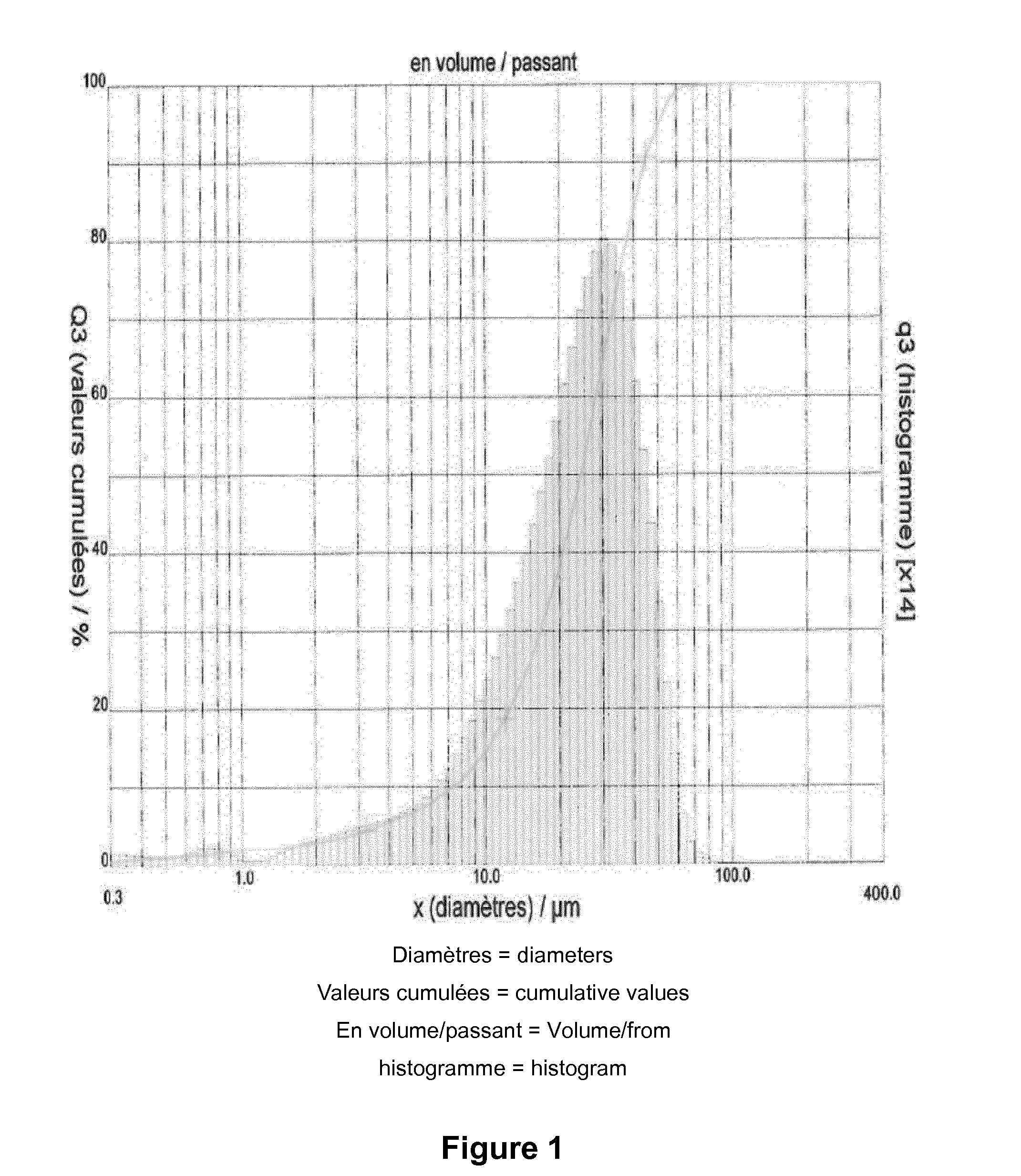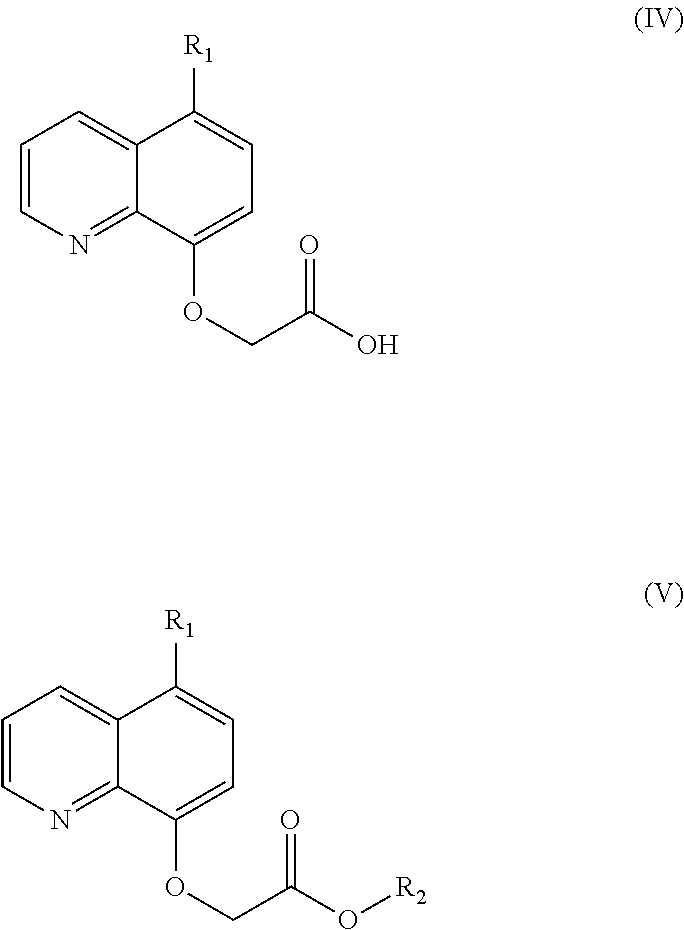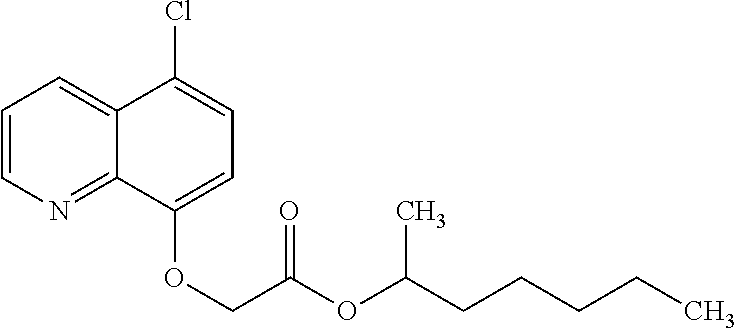Process for the preparation of a quinoline carboxylic acid
- Summary
- Abstract
- Description
- Claims
- Application Information
AI Technical Summary
Benefits of technology
Problems solved by technology
Method used
Image
Examples
example 1
Preparation of (RS)-1-methylhexyl (5-chloroquinolin-8-yloxy)acetate (cloquintocet-mexyl)
[0068]
[0069]A solution 53.9 g (0.30 mol) of 5-chloro-2-hydroxyquinoline (“CHQ”) in 136 g of NMP (N-methyl pyrolidinone) and 60 g of toluene was stirred at 45° C. in a 1 L jacketed vessel. A solution of sodium hydroxide (25%) (11.4 g, 0.285 mol) was added over 20 minutes. The temperature was raised to 85° C. and the water was removed under vacuum by azeotropic distillation. When all the water was removed, a further 35 g of toluene is distilled.
[0070]K2CO3 (4.15 g, 0.03 mol) was added to the reaction mixture, followed by the addition of chloro-acetic acid-1-methylhexyl ester 59.15 g (0.360 mol) over 1 hour. When the addition was complete, the temperature was raised to 95° C. and the reaction mixture is stirred for a further 3 hours. After control of the reaction completion the solvent was removed under vacuum to obtain the crude cloquintocet-mexyl as a melt.
example 2
Preparation of (5-chloroquinolin-8-yloxy)acetic acid (cloquintocet acid)—acidic hydrolysis (invention)
[0071]
[0072]The melt from Example 1 was cooled to 90° C. and 415 g of demineralised water was added. Subsequently, 41.1 g (0.36 mol) of aqueous hydrochloric acid (32%) was added and the mixture heated under reflux. The 2-heptanol released during the hydrolysis was distilled off and separated using a Dean-Stark apparatus. After completion of the hydrolysis and complete removal of the 2-heptanol, a solution of 25% of sodium hydroxide (59.3 g) was added over a period of 2 hours maintaining the temperature at 90° C. until pH of 2.8 was reached. The resulting suspension was cooled to 20° C. and the solid filtered, washed with 2×50 mL of water and finally dried to provide 63.7 g of cloquintocet acid. (Titration by NaOH=95.4%). The filtration time was 15 seconds.
[0073]The cloquintocet acid obtained had the following particle size distribution, as measured by diffraction laser particle size...
example 3
Synthesis, Isolation of Identification of Cloquintocet Acid Hydrochloride, Starting from cloquintocet-mexyl
[0075]
[0076]A suspension of 70.70 g of cloquintocet-mexyl (96.9% strength) in 205 g of demineralised water was stirred at 100° C. in a 1L jacketed glass vessel. 27.5 g of aqueous hydrochloric acid [32%] was slowly added, and the reaction mixture was stirred under reflux for 6 hours. The biphasic solution was then cooled down to 20° C. over 4 hours and the resulting suspension was filtered and the solid was wash with 2×50mL of demineralised water and dried. Cloquintocet acid hydrochloride (35.55 g) was isolated as a light brown solid.
[0077]Elemental analysis: C=48.7%, H=3.5%, N=5.2%, Cl=24.7%. Calculated: C=48.20%, H=3.31%, N=5.11%, Cl=25.87%.
PUM
| Property | Measurement | Unit |
|---|---|---|
| Temperature | aaaaa | aaaaa |
| Length | aaaaa | aaaaa |
| Length | aaaaa | aaaaa |
Abstract
Description
Claims
Application Information
 Login to View More
Login to View More - R&D Engineer
- R&D Manager
- IP Professional
- Industry Leading Data Capabilities
- Powerful AI technology
- Patent DNA Extraction
Browse by: Latest US Patents, China's latest patents, Technical Efficacy Thesaurus, Application Domain, Technology Topic, Popular Technical Reports.
© 2024 PatSnap. All rights reserved.Legal|Privacy policy|Modern Slavery Act Transparency Statement|Sitemap|About US| Contact US: help@patsnap.com










